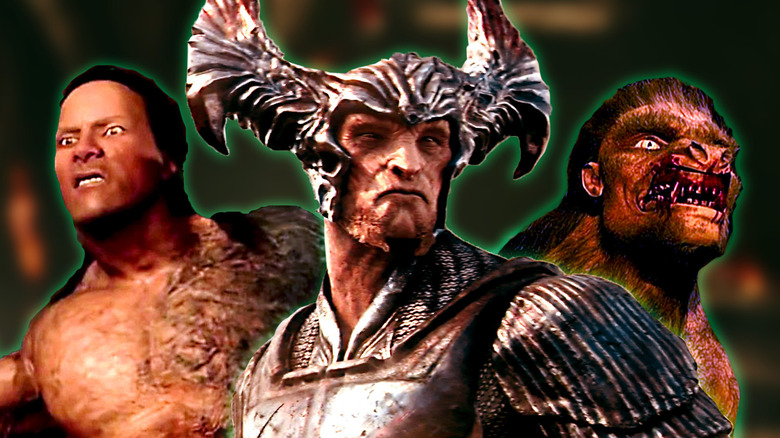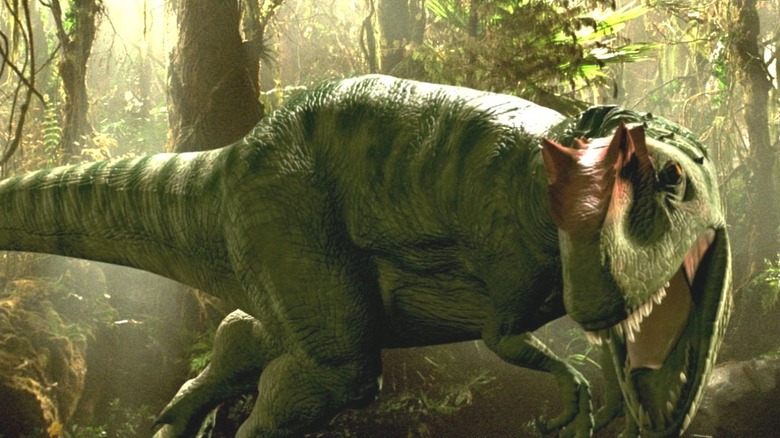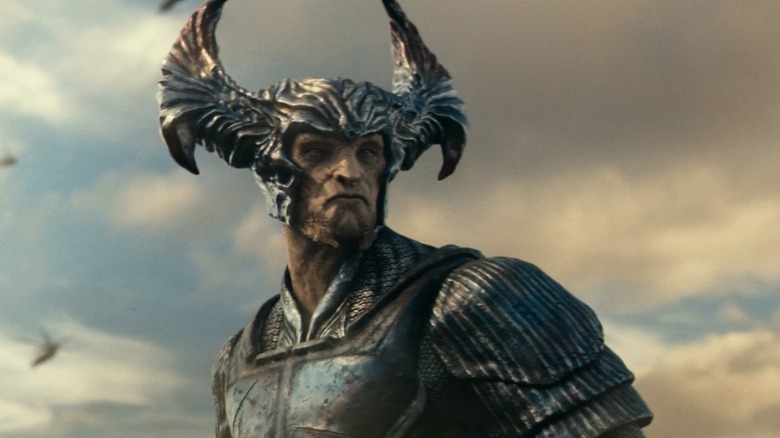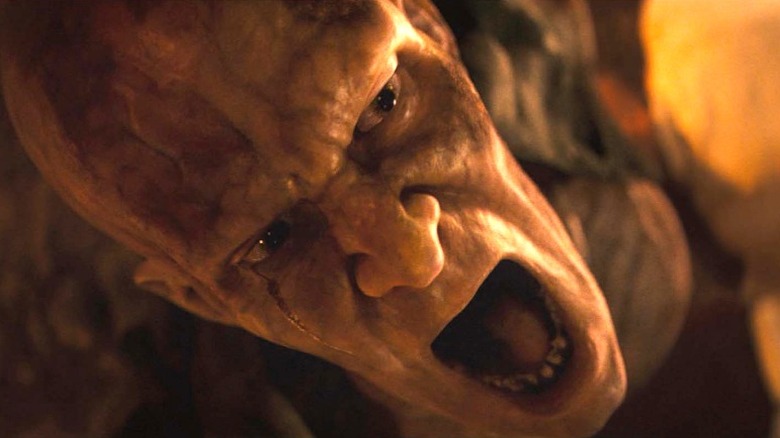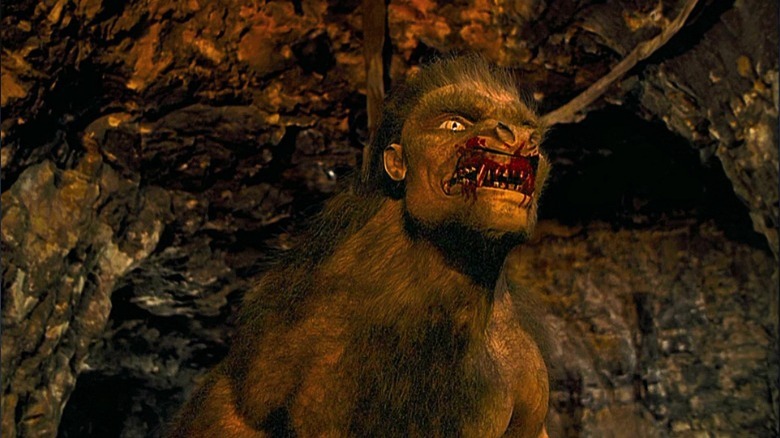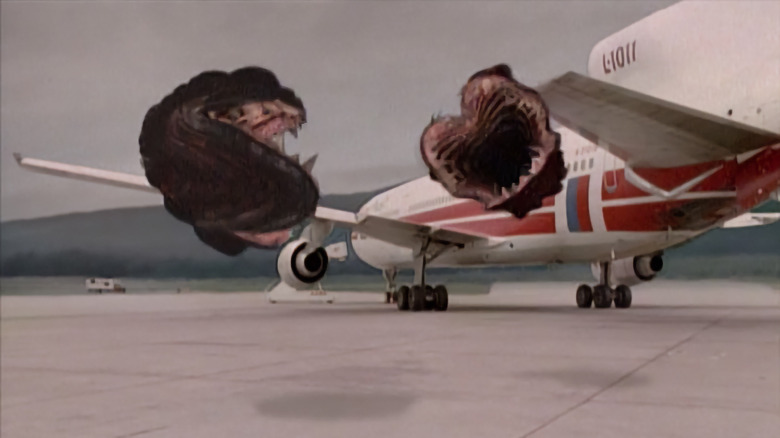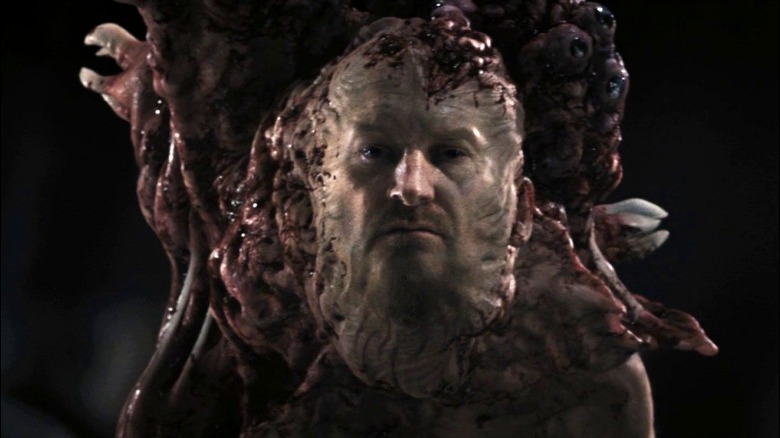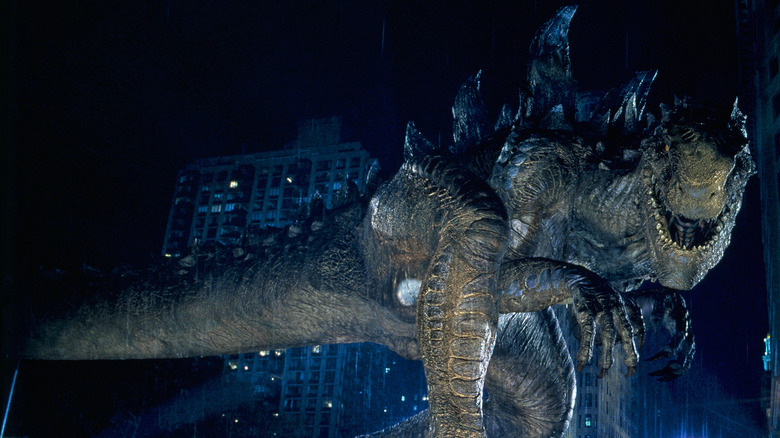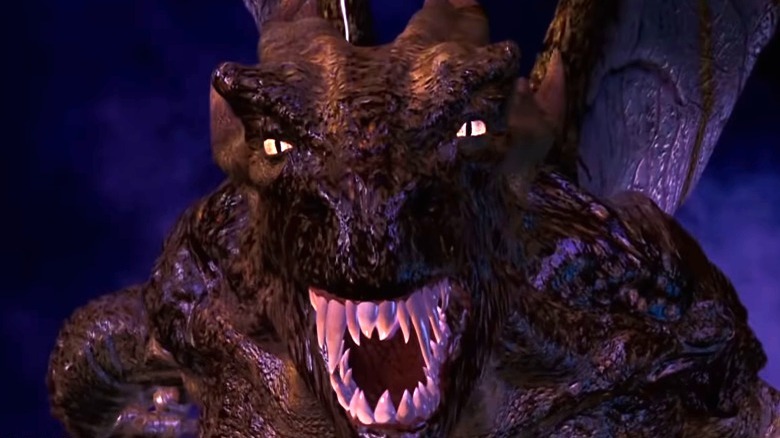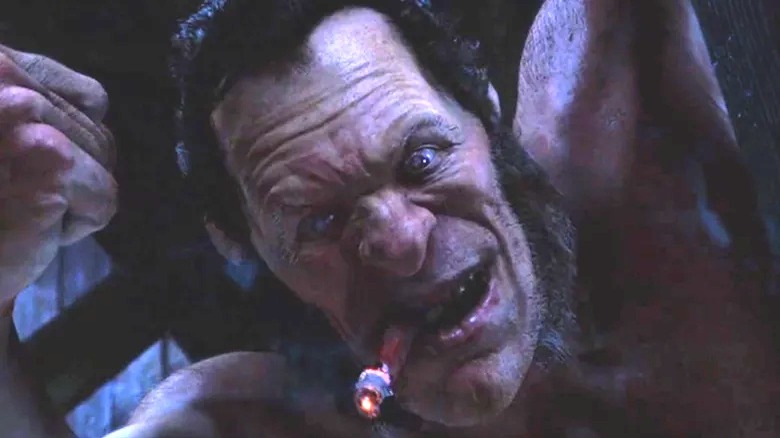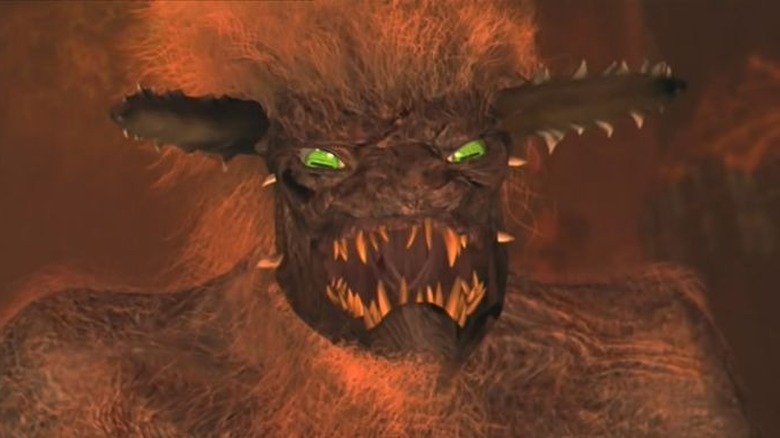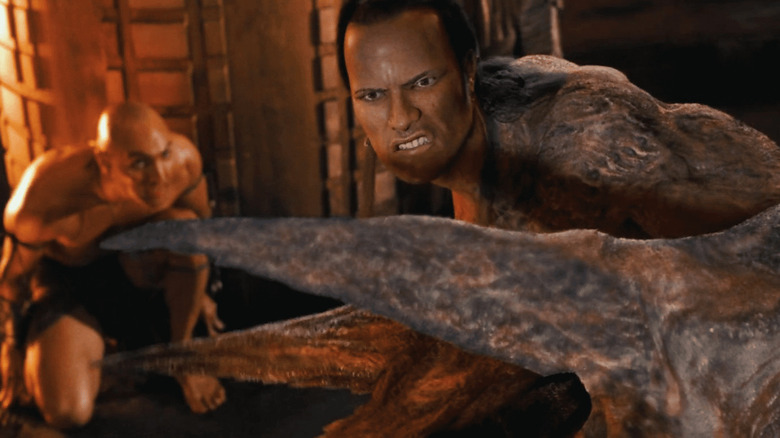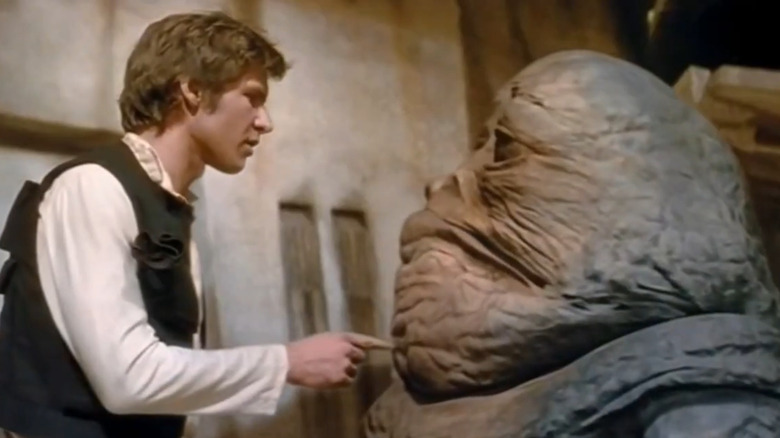Why These 12 CG Monsters Missed The Mark
Digital effects can be an amazing resource for creating fantasy worlds and creatures, but like any tool, they can be misused. Early CGI in projects like "The Abyss," "Young Sherlock Holmes," and, of course, "Jurassic Park" blew people's minds, and studios that had previously relied on miniatures and stop-motion animation all of a sudden wanted their own computerized creations.
But making digital characters isn't that simple, and the results are often less than stunning. This is rarely the fault of the modelers, animators, or other professionals who work tirelessly to bring these creatures to life. Sometimes, the time and money just isn't there. Sometimes, puppets simply work better. Even if the CGI is well done, it can destroy the characters' charm and undermine what the movie was going for in the first place.
The misbegotten CGI effects that follow fall into all of those categories. Plenty of them are bad, some are arguably good, and almost all are ugly. However, in every case, circumstances led to a worse result than would have been ideal. Let's look at the worst CG monsters in movies and TV history, and examine why they didn't live up to their potential.
The dinosaurs in A Sound of Thunder
In 1993, "Jurassic Park" redefined onscreen dinosaurs via ground-breaking computer animation, a $63 million budget, a screenplay based on Michael Crichton's popular novel, and the sure hand of Steven Spielberg as director. Twelve years later, 2005's "A Sound of Thunder" ... didn't.
Sure, it was also based on strong literary source material — in this case, a Ray Bradbury short story that also deals with humans who encounter dinosaurs, as well as some chaos theory. Every other aspect, however, fell short. Directors and stars changed and left, budgets collapsed, and the production faced numerous delays. Per Bomb Report, Franchise Pictures, the production company behind the film, was forced to repay a sizable loan after filming got off to a late start, and the film's $80 million budget evaporated following a different lawsuit. Given that most of that money was earmarked for VFX, that was a major problem.
According to VFX World, a massive flood didn't help, ruining the vegetation on an elaborate jungle set and throwing the schedule into chaos. Filming was eventually completed, but "A Sound of Thunder" was held by the studio for three years before it was released with noticeably unfinished effects. Audiences and critics responded accordingly.
Steppenwolf in Justice League
The alien menace Steppenwolf first appears at the end of the extended cut of "Batman v Superman: Dawn of Justice" as a menacing holographic image who communicates with Lex Luthor. Shadowy and horned, he looks Satanic and scary. Then, "Justice League" came out, and revealed him to be merely a tall, gray-skinned dude in a winged helmet. "Zack Snyder's Justice League" subsequently revealed this design to be a long way from what Snyder originally wanted, which was a terrifying armored monstrosity. So, why did the version of Steppenwolf in Joss Whedon's theatrical cut look so much less threatening?
Talking to Polygon, producer Deborah Snyder said, "The studio didn't like the way he looked ... I don't know if it was too menacing or scary, but we redesigned him." In a breakdown of his director's cut trailer for VERO, Zack Snyder added, "I think the initial thought was that he was a little too scary and a little too alien and a little too intense." Naturally, when Snyder returned to finish his own cut of the movie, he went back to the original version. "One of the things Zack said was, 'If this is my my [sic] vision of the film, I want to put back the things that got changed — even the things that got changed along the way,'" Deborah recalled.
In this instance, it sounds like Whedon — who was hired at least in part to incorporate Warner Bros' notes for "Justice League" — may not be the obvious scapegoat after all.
The zombie-vampires in I Am Legend
Richard Matheson's novel "I Am Legend" has been adapted into major motion pictures three times. In the first two, "The Last Man on Earth" and "The Omega Man," his albino vampires possess some degree of intelligence, positioning them as serious threats to Vincent Price and Charlton Heston, respectively. The third time was not the charm. In the 2007 adaptation, which stars Will Smith as the primary survivor of a global plague, the "Darkseers" are portrayed as zombie-vampire hybrids who remain savage and animalistic, save in a deleted ending released only on DVD.
In an attempt to make the creatures seem less human, on-set actors wearing makeup were swiftly replaced by digital doubles who appeared almost translucent. It did make them seem more abnormal, but it did not assist viewers in believing they were real.
Director Francis Lawrence explained his logic to the New York Times. "We just weren't able to get out of people what we really wanted," he said. "They needed to have an abandon in their performance that you just can't get out of people in the middle of the night when they're barefoot. And their metabolisms are really spiked, so they're constantly hyperventilating, which you can't really get actors to do for a long time or they pass out." Considering there's been talk of an "I Am Legend" sequel as recently as March 2022, the decision can't have been a deal-breaker in the end.
The titular creatures in An American Werewolf in Paris
When "An American Werewolf in Paris" came out, director Anthony Waller was convinced that he had some groundbreaking special effects on his hands. In a 1998 interview with Sci-Fi Universe, he hyped up "the first CG werewolf in movie history." Stating bluntly that he did not think the visuals would age badly, he said, "The gap between the state-of-the-art in 1987 and 1997 is much larger than the gap between 1997 and 2007 will be. We're getting closer to perfection. Once we can produce something that's absolutely, 100% believable, you won't be able to improve on it."
To put it mildly, time has been harsher than Waller imagined it would be. There's no doubt that CGI seemed impressive when it was new and groundbreaking, and Waller is clearly dazzled by his own creation when he describes "a transformation sequence, where the female lead is turning into a werewolf. It's one continuous shot, starting with her real head, which is changed through makeup, and pans down an animatronic wolf's body, six nipples and all, and then down to a pair of CG legs." The way those limbs crack and contort into a canine's may be unusual, but there's a difference between being cool and being realistic. Even at the time, the critics weren't having it.
The Langoliers
In the TV adaptation of Stephen King's novella "The Langoliers," the eponymous creatures are like extra-dimensional Pac-Men that gobble up reality itself. That's inherently the kind of thing that works better on the page. King describes the monsters as resembling "balls, sort of like beach balls, but balls which rippled and contracted and then expanded again ... Faces lurked below the surfaces of the racing balls — monstrous, alien faces. They shimmered and twitched and wavered like faces made of glowing swamp-gas. The eyes were only rudimentary indentations, but the mouths were huge: semicircular caves lined with gnashing, blurring teeth."
King has a way with words. The CGI artists working on the film had a way of translating his prose into objects that looked like torn-open passion fruits. According to CinemaBlend, ABC really did spend money on those effects, but it was TV money and the year was 1995. The original Pac-Man himself might have been almost as convincing. Still, the miniseries does have its fans, at least one of whom has created the movie's very own Facebook page.
The Thing in the 2011 prequel
John Carpenter's "The Thing" remains a beloved sci-fi horror movie in large part because of its impressively terrifying practical effects. When stomachs open into mouths, severed heads become spiders, and tentacles explode out of a dog, it feels real because it is. To this day, the viewer wonders how the hell 21-year-old makeup effects artist Rob Bottin pulled it all off. On the other hand, the 2011 prequel, in which events unfold so similarly that it's also effectively a remake, never makes the viewer wonder at all. The creature is clearly computer generated, and as such our minds expect it to morph and shift.
Frustratingly, artists Alec Gillis and Tom Woodruff Jr. actually did create practical effects for the movie, only to have them replaced by digital equivalents later. In an interview with SciFiNow, Gillis said, "We were kind of in the doldrums after 'The Thing' came out. It was yet another film where we found ourselves commiserating with guys like Rick Baker or the guys at Legacy about doing work that gets replaced by digital."
However, director Matthijs van Heijningen Jr. told Den of Geek that "although we shot the film practically, at the end of the day, it didn't hold up. It looked a bit like an '80s movie, actually ... So, we enhanced it with CG[I]." There's a good reason why those '80s horror movies have more staying power, though — this computer-generated beast didn't look great in its day, and it looks even worse now.
Roland Emmerich's Godzilla
Unlike some of the other entries on this list, the Godzilla in Roland Emmerich's 1998 film doesn't look bad. As a matter of fact, for a giant lizard, it's pretty realistic. It just doesn't look much like Godzilla. Sure, it has back spines and a tail, and kinda-sorta breathes fire. The similarities end there, though. The weird boxy head and its posture make it look more like a "Star Wars" rancor than Toho's original man-in-suit creation.
Emmerich recently told The Hollywood Reporter that his Godzilla redesign was intended to be a "Producers"-like move to get himself fired. As he recalls, "I didn't want to do 'Godzilla.' But they made me a deal, which was unheard of. I said, 'OK, let's go about this really radically. I'm not doing big-belly Godzilla. I'm doing him as a lizard.' That was supposed to tell everybody I can't do this movie. [Toho] said, 'Oh, we'll call this the new Godzilla, the Hollywood Godzilla. Then, we can still do our fat Godzilla.'"
But Toho got the last laugh. In Toho's 2004 film "Godzilla: Final Wars," a version of Emmerich's lizard, one made by digitally scanning a 1998 action figure, was swiftly defeated by the original Godzilla. For die-hard fans, it's one of the most satisfying parts of a very satisfying movie.
The Animalities in Mortal Kombat: Annihilation
For its time, the first "Mortal Kombat" movie was a groundbreaking mix of practical puppetry, CGI, and the type of wire work that was rarely seen in Hollywood at the time. The sequel? Not so much. Cramming in as many characters as possible from the second and third games, with only two returning actors and a first-time director behind the camera, it felt like a quick cash-in. During production, however, star and choreographer Robin Shou was optimistic about its chances. "Thanks to motion-capture," he told Film Scouts, "we now have world-class martial artists battling CG characters. In this movie, we'll also be doing advanced martial arts, including lots of exciting aerial maneuvers and flying kicks, which will subsequently be digitally enhanced."
Shou knows his martial arts, but he's less of an expert in CGI, and couldn't have predicted how clunky the final product would turn out. This is particularly evident in the final battle, which features a battle between a digital dragon and a hydra that looks less impressive than the graphics in an actual "Mortal Kombat" game.
If you think these visuals seem like unfinished pre-vis, you're not wrong — producer Larry Kasanoff has admitted as much. In the book "Lights, Camera, Game Over!" (via Flickering Myth), Kasanoff said, "The effects in that movie are not the final effects. I never anticipated that someone would take the movie and go, 'It's good enough.' We weren't done. We never finished that movie. But the studio said, 'we don't care.' We sacrificed quality for business."
Mr. Hyde in Van Helsing
There are many digital creatures in "Van Helsing," director Stephen Sommers' campy 2004 tribute to the classic Universal monsters. Many of them look good for the time. Some even hold up now. When allocating resources for a monster mashup like this one, however, it makes sense to put the lion's share into the main event players: Dracula, Frankenstein, and Wolf Man. The star of the opening act, Mr. Hyde, doesn't fare quite so well. As Below the Line put it, "budgetary and strategic determinations meant that some characters would be totally digital."
As Steven Padnick writes at Tor.com, Mr. Hyde, at least as originally written by Robert Louis Stevenson, is not some physically enlarged monster, but simply Dr. Jekyll unleashing his id. His posture may be worse, but he should be human-sized. He's not the Incredible Hulk. Robbie Coltrane would have been a great choice to play him as a human, but was instead stuck giving voice to an Andre the Giant-like cartoon.
It's hardly shocking that Sommers wasn't faithful to the source material, as none of the monsters in the movie are, nor did audiences expect them to be. However, in this case, going classic might have saved some money and credibility.
Malebolgia in Spawn
1997's "Spawn" is a movie about a superhero from Hell, with more good creature effects than bad. Unfortunately, the bad ones stick out in folks' memories the most. In the plus column, ILM handled the effects for the Violator, an impressive mixture of a 13-foot puppet and digital animation. However, when Spawn goes to Hell, the movie does, too. During production, special effects producer Tom Peitzman said, "This horrific environment is something people will not have seen before." He was right, but probably not in the way he meant.
What ensues looks like a PlayStation 2 cut scene. Initially, a puppet creature was created to represent the demon Malebolgia, an off-brand Satan and the movie's final boss. We know this because it served as the basis for action figures, and got its own trading card specifying that it was originally a physical effect.
For whatever reason, though, the puppet was replaced by a significantly less convincing digital model. Because Santa Barbara Studios also created the creatures for "An American Werewolf in Paris," fans have speculated that Malebolgia is simply a recycled werewolf model. Whether that's true or not, the character remains a general source of ridicule in a movie that features some truly impressive makeup from KNB and one of the first convincing CG superhero capes years before that was the standard. It's sort of a shame.
The Scorpion King in The Mummy Returns
Dwayne Johnson's a big movie star now, but in his feature film debut, "The Mummy Returns," he doesn't do much but walk around in the desert and fall over. When it's time for his character to come back for the big climax, he does so as a computer-generated man-bug hybrid that gets the scorpion parts right, but hits the uncanny valley when it comes to re-creating The Rock.
The movie's VFX supervisor, John Berton Jr., blames some of that on The Rock's hectic WWE schedule. "The biggest thing about the Scorpion King in this movie is that we didn't have the reference that we needed," he said in a video with Corridor Crew. "We needed a day with Dwayne Johnson to photograph his face and eye detail and all the stuff that you would do. Because he was busy with his incredible WWE career that was not possible. We had him for I think three days, maybe, in Morocco to shoot his scenes."
Berton admits that the animation was intentionally "cartoony," and thinks the effect would've worked better with more reference material, better technology (particularly for details like the pores on the Scorpion King's skin), and less of a focus on the character's face. In the end, though, it didn't really matter. When Johnson came back for the prequel "The Scorpion King," he ditched the monster aspect, and the rest is movie-star history.
Jabba the Hutt in the Star Wars Special Edition
Early adopters of a new technology can be blind to its flaws. This was certainly the case with George Lucas. The filmmaker was so enamored with the ability to create CG creatures that he dug up an unfinished Jabba scene filmed for the original "Star Wars," one that originally had a human actor in the role, and gussied it up with CGI for 1997's "Special Edition" of "Episode IV." It was a memorable flex of Lucas' new tech, but was it a convincing replacement for the "Return of the Jedi" puppet? No. It looked like a waterbed in motion.
Apparently, even Lucas agreed, because for the 2004 DVD release of the film, he took another pass at Jabba, making him look more like the improved digital model used in 1999's "Star Wars: Episode I — The Phantom Menace." Neither quite matches the original puppet, but at least the latter Jabbas look like real creatures.
On the "Return of the Jedi" DVD commentary track (by way of The DVD Journal), Lucas says, "I'm still amused by people who somehow think that when you use cyber-technology or digital technology in movies, suddenly it's 'fake' — but when you look at a scene in here in Jabba's palace, now there's some digital characters in here, but they're no more or less fake than all the other characters in here. I mean, is a digital character more fake than a big fat rubber character?" If we're comparing Jabbas? Yes, George. Yes, it really is.
